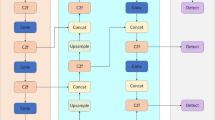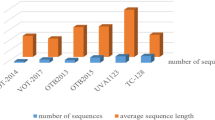Abstract
In this paper, we presents a new method for extracting interest points from RGB images by complex network analysis theory. Firstly, the RGB images are expressed as the multi-level complex network model. The nodes in the complex network model are the maximum degree pixel of subgraphs and the links are the similarity and distance between the maximum degree pixels. Then three different algorithms were proposed to locate these interest points based on three topology features of high-level complex network model, which are degree, closeness and betweenness centrality. In order to verify the effectiveness of our algorithm, we use our algorithm for four different test images. It is remarkable that the identify targets by degree centrality algorithm are similar to Harris and SIFT algorithm, and the accuracy are more than them. The results show that our algorithm could identify interest points from the images effectively.











Similar content being viewed by others
References
Sun, X., Zhao, K., et al. (2016). Scale-invariant interest point detection in images based on complex network analysis. ICIC Express Letters, Part B: Applications, 7(3), 525–530.
Vespignani, A. (2010). Complex networks the fragility of interdependency. Nature, 464(7291), 984–985.
Gao, J. X., Barzel, B., et al. (2016). Universal resilience patterns in complex networks. Nature, 530(7590), 307–312.
Barabasi, A. L. (2013). Network science. Philosophical Transactions of the Royal Society a-Mathematical Physical and Engineering Sciences, 371(1987), 1–3.
Barabasi, A. L. (2012). Network science luck or reason. Nature, 489(7417), 507–508.
Criado, R., Romance, M., et al. (2012). A post-processing method for interest point location in images by using weighted line-graph complex networks. International Journal of Bifurcation and Chaos in Applied Sciences and Engineering, 22(7), 1250163.
Zhenxing, W., Xi, L., et al. (2015). Image edge detection based on local dimension: A complex networks approach. Physica A: Statistical Mechanics and its Applications, 440, 9–18.
Xu, D. G., Chen, X., et al. (2015). Complex networks-based texture extraction and classification method for mineral flotation froth images. Minerals Engineering, 83, 105–116.
Banerjee, S. J., Azharuddin, M., et al. (2015). Using complex networks towards information retrieval and diagnostics in multidimensional imaging. Scientific Reports, 5, 17271.
Tang, J., Chen, Y., et al. (2013). Image modeling and feature extraction method based on complex network. Computer Engineering, 39(5), 243–247.
Egerstedt, M. (2011). Complex networks degrees of control. Nature, 473(7346), 158–159.
Wang, X. R., Trajanovski, S., et al. (2016). Degree distribution and assortativity in line graphs of complex networks. Physica a-Statistical Mechanics and Its Applications, 445, 343–356.
Deng, W. B., Li, W., et al. (2011). The exponential degree distribution in complex networks: Non-equilibrium network theory, numerical simulation and empirical data. Physica a-Statistical Mechanics and Its Applications, 390(8), 1481–1485.
Newmen, M. E. J. (2010). Networks: An introduction. New York: Oxford University Press.
Du, Y., Gao, C., et al. (2015). A new closeness centrality measure via effective distance in complex networks. Chaos, 25(3), 033112.
He, S., Li, S., et al. (2009). Betweenness centrality in finite components of complex networks. Physica a-Statistical Mechanics and Its Applications, 388(19), 4277–4285.
Nie, T. Y., Guo, Z., et al. (2016). The dynamic correlation between degree and betweenness of complex network under attack. Physica a-Statistical Mechanics and Its Applications, 457, 129–137.
Acknowledgements
This work is supported partially by the Jilin Province of China in the Science and Technology Development Plan Project (Grant No. 20170520057JH), partially by the Jilin Province of China in the Science and Technology Development Plan Project (Grant No. 20160418038FG), partially by the Jilin Province of China in the Science and Technology Development Plan Project (Grant No. 20160312017ZX), partially by the Jilin Province department of education Science and Technology Plan Projects (Grant No 201658), partially by the Beihua University Dr. Scientific Research Fund (Grant No. 2015557).
Author information
Authors and Affiliations
Corresponding author
Rights and permissions
About this article
Cite this article
Zou, Q., Bai, J. Interest Points Detection in Image Based on Topology Features of Multi-level Complex Networks. Wireless Pers Commun 103, 715–725 (2018). https://doi.org/10.1007/s11277-018-5472-4
Published:
Issue Date:
DOI: https://doi.org/10.1007/s11277-018-5472-4




